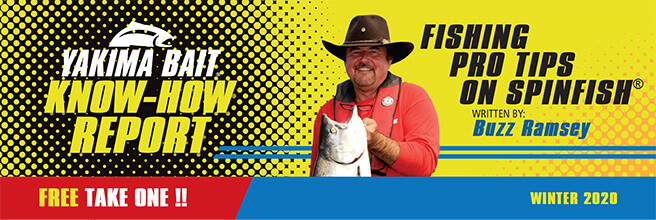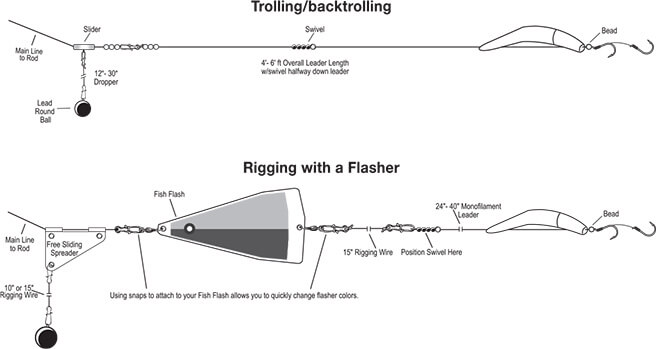Fishing Pro Tips on SpinFish®

 Anglers everywhere often combine lure and bait, or scent, in an effort to make lures twice as effective. Consider, for example, how walleye anglers often tip their plug or spinner with a worm, savvy bass anglers’ spray a fish attractant on lures – even soft plastics, and those chasing steelhead add an egg cluster to a single egg imitation drifted near river bottoms.
Anglers everywhere often combine lure and bait, or scent, in an effort to make lures twice as effective. Consider, for example, how walleye anglers often tip their plug or spinner with a worm, savvy bass anglers’ spray a fish attractant on lures – even soft plastics, and those chasing steelhead add an egg cluster to a single egg imitation drifted near river bottoms.
A new concept in combining lure-and-bait to produce more and bigger fish is a new trolling lure called SpinFish®. SpinFish, made by Yakima Bait, is a pull-apart, fallible plug featuring a patented “Easy-Fill” bait chamber that disperses scent as it’s pulled through the water column. And while it’s non-buoyant design makes it more of a trolling plug, it can be still-fished in river current, even back-trolled down rivers behind a diver or weight by rigging a buoyant bobber or float a few feet up the leader to prevent the plug from hanging up where bottom currents might go slack.
SpinFish produces a vibrating, spinning, wounded-baitfish action when pulled through the water. Because it’s designed to spin, it can be rigged to spin clockwise or counter-clockwise, just re-thread your leader through the opposite hole in the lure lip. It can be rigged 36-to-60 inches behind Fish Flash®, Free-Sliding Spreader, diver, Spin-N-Glo® Bottom Walker, or conventional sinker; 18-to-42 inches behind dodgers or rotating flashers. To reduce/eliminate line or leader twist it should be rigged in conjunction with a swivel.
 It’s easy to add bait and/or scent to this lure, just pull apart and fill with any fresh or live bait, which might include: tuna, herring, sardines, candlefish, alewife or other critters game-fish prey on; prepared bait like Pro Cure, PowerBait, or Gulp! work too. To keep your SpinFish fresh smelling, it’s important to clean this lure thoroughly after use. And, because the leader is threaded through both halves, there is just no way (bar a line break) you can lose or misplace the lure halves. The all-new SpinFish comes in two sizes, a 3.0 three-inch and 4.0 four-inch version, rigged and ready to fish.
It’s easy to add bait and/or scent to this lure, just pull apart and fill with any fresh or live bait, which might include: tuna, herring, sardines, candlefish, alewife or other critters game-fish prey on; prepared bait like Pro Cure, PowerBait, or Gulp! work too. To keep your SpinFish fresh smelling, it’s important to clean this lure thoroughly after use. And, because the leader is threaded through both halves, there is just no way (bar a line break) you can lose or misplace the lure halves. The all-new SpinFish comes in two sizes, a 3.0 three-inch and 4.0 four-inch version, rigged and ready to fish.
What I noticed when trolling this lure in combination with a Fish Flash at the Columbia River mouth for fall salmon is that I had a better hook-to-land ratio if I let salmon pull the rod down a couple times before setting the hook. If I yanked back to set the hook too soon, I would miss hooking a least half of the salmon that attacked this lure. In addition, I discovered that the lure had more lifelike/aggressive action if I didn’t over stuff the bait chamber. Bait cut from anchovy is what I used.
 Pro fisherman John Keizer of Washington had good luck trolling SpinFish for winter blackmouth (chinook) in Puget Sound. Here is what he had to say: We ran the SpinFish behind medium size Fish Flash and 11” rotating flashers and had very good success on blackmouth. You just pull apart the body and fill with any bait. I had the best results using canned Chicken of the Sea Tuna (packed in oil). I rigged my SpinFish 25-40 inches behind a Fish Flash or 35-45 inches behind rotating ashers. Unlike other bait holding lures, SpinFish needs no rubber bands to keep the lure together. I normally have 4-5 SpinFish loaded with different bait scents and ready to swap out each time I check my gear. Check out John’s YouTube video: https://www.youtube.com/watch?v=hoN5vUR12Tw
Pro fisherman John Keizer of Washington had good luck trolling SpinFish for winter blackmouth (chinook) in Puget Sound. Here is what he had to say: We ran the SpinFish behind medium size Fish Flash and 11” rotating flashers and had very good success on blackmouth. You just pull apart the body and fill with any bait. I had the best results using canned Chicken of the Sea Tuna (packed in oil). I rigged my SpinFish 25-40 inches behind a Fish Flash or 35-45 inches behind rotating ashers. Unlike other bait holding lures, SpinFish needs no rubber bands to keep the lure together. I normally have 4-5 SpinFish loaded with different bait scents and ready to swap out each time I check my gear. Check out John’s YouTube video: https://www.youtube.com/watch?v=hoN5vUR12Tw
 Denis Isbister of Wild Fish Wild Places TV fame was the first angler to troll SpinFish in the ocean off the rugged British Columbia coast line where he found success trolling them in combination with 11” rotating flashers and medium size Fish Flash. Both flasher set ups produce equally well. What we loved about the new SpinFish as opposed to using herring or anchovy was that if we missed a bite we could just leave the SpinFish down and keep trolling as opposed to having to pull our lines to check our bait. The guides we fished with were skeptic at first about using SpinFish but became true believers.
Denis Isbister of Wild Fish Wild Places TV fame was the first angler to troll SpinFish in the ocean off the rugged British Columbia coast line where he found success trolling them in combination with 11” rotating flashers and medium size Fish Flash. Both flasher set ups produce equally well. What we loved about the new SpinFish as opposed to using herring or anchovy was that if we missed a bite we could just leave the SpinFish down and keep trolling as opposed to having to pull our lines to check our bait. The guides we fished with were skeptic at first about using SpinFish but became true believers.
 Fishing 411 TV hosts Mark and Jake Romanack first trolling SpinFish during the 2019 mid summer season on Lake Ontario. What worked was to rig SpinFish 48 inches behind a 6 inch Fish Flash and run 40 to 50 feet behind the downrigger release. We kept our trolling speed at from 2 to 2.5 MPH. We stuffed the easy-fill bait chamber with pieces of herring topped off with Pro Cure Super Gel. We’re sure other baits would work too, but stayed with what first worked. What we noticed was that a slower spin rate on the SpinFish seemed to produce better than a fast one, at least on that day, which we were able to achieve by filling the bait chamber pretty full. Given the success we experienced for salmon we are looking forward to trying the 3.0 size SpinFish for walleye.
Fishing 411 TV hosts Mark and Jake Romanack first trolling SpinFish during the 2019 mid summer season on Lake Ontario. What worked was to rig SpinFish 48 inches behind a 6 inch Fish Flash and run 40 to 50 feet behind the downrigger release. We kept our trolling speed at from 2 to 2.5 MPH. We stuffed the easy-fill bait chamber with pieces of herring topped off with Pro Cure Super Gel. We’re sure other baits would work too, but stayed with what first worked. What we noticed was that a slower spin rate on the SpinFish seemed to produce better than a fast one, at least on that day, which we were able to achieve by filling the bait chamber pretty full. Given the success we experienced for salmon we are looking forward to trying the 3.0 size SpinFish for walleye.


